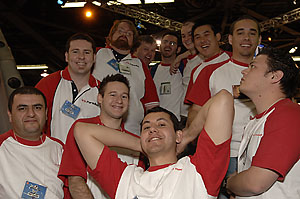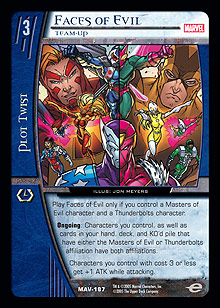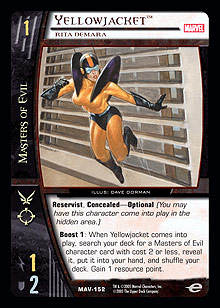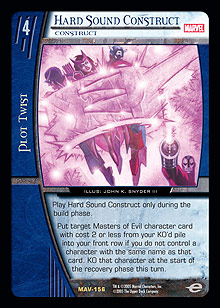 The process that led to the Australians playing Faces of Evil at PC: LA 2005 involved many late nights and a ton of elbow grease, with a few dollops of sheer artistry thrown in from time to time. Since returning from the US, I have struggled to articulate the things that separate this deck from your run-of-the-mill rogue strategy. This was truly a labour of love for many contributors, so I hope the following does them justice.
The process that led to the Australians playing Faces of Evil at PC: LA 2005 involved many late nights and a ton of elbow grease, with a few dollops of sheer artistry thrown in from time to time. Since returning from the US, I have struggled to articulate the things that separate this deck from your run-of-the-mill rogue strategy. This was truly a labour of love for many contributors, so I hope the following does them justice.
Faces of Evil is the superior off-curve rush strategy of Golden Age. Faces is more consistent than either The New Brotherhood or Squadron Supreme while retaining enough aggression to win games on fifth and sixth turn initiatives. Additionally, Faces has much more flexibility than other rush strategies, giving it more room to maneuver in unfamiliar scenarios or against dedicated hate.
The list:
Faces of Evil
Alex Brown, PC:LA 2005
4 Yellowjacket
3 Paul Ebersol ◊ Fixer
2 Beetle ◊ Mach 1
1 Dallas Riordan, Mayoral Aide
1 Ogre
1 Joystick
1 Nathan Garrett ◊ Black Knight, Corrupt Crusader
1 Radioactive Man, Chen Lu
1 Ratcatcher
4 Melissa Gold ◊ Songbird, Sonic Carapace
4 Beetle, Armorsmith
1 Melissa Gold, Screaming Mimi
1 Blizzard
1 Melter
1 Shocker
1 Kyle Rayner, Last Green Lantern
1 Foxfire
3 Speed Demon, Second Chance Speedster
4 Birthing Chamber
4 Faces of Evil
4 Mega-Blast
4 No Man Escapes the Manhunters
3 The Wrecking Crew
3 Flying Kick
3 Hard Sound Construct
3 Null Time Zone
 Faces of Evil is an off-curve combat deck. Instead of following the normal curve combat strategy of playing the largest single character each turn, Faces of Evil tries to overwhelm its opponent with a horde of smaller characters. There are advantages and disadvantages to a strategy like this that will be addressed in the following paragraphs.
Faces of Evil is an off-curve combat deck. Instead of following the normal curve combat strategy of playing the largest single character each turn, Faces of Evil tries to overwhelm its opponent with a horde of smaller characters. There are advantages and disadvantages to a strategy like this that will be addressed in the following paragraphs.
For an off-curve combat deck to be successful, it needs to prevent an opponent from putting his or her own plans into action. Achieving this is hardly easy, as there are several strategic imperatives that must be satisfied. Although I do not claim to have an exhaustive list of what is necessary to make such a plan work, I will outline some of the key points below.
Firstly, an off-curve deck needs to be able to use all of its resource points. This involves a much larger investment than you’d see in a normal curve deck, which only requires a resource and a single character card a turn for the most part. In the case of this deck, Birthing Chamber, Yellowjacket, and Dallas Riordan provide extra cards to maximize the chances of drawing enough characters to fill the curve. Additionally, filling out the curve with as many non-unique characters as possible allows for consistent use of all resource points, ensuring that we put ourselves in the best possible board position we can. Uniqueness is a significant issue for any off-curve strategy, and is worth keeping in the forefront of your mind as this article continues.
Secondly, an off-curve combat deck needs to have the best possible early game. Off-curve combat decks aim to hit the ground running on turn 1 and finish the game before the curve decks can outlast them with a succession of larger and larger characters. For this reason, a card like Melissa Gold ◊ Songbird, Sonic Carapace is included in the maximum quantity, even though uniqueness is a worry, as you simply must have the best early game possible.
Thirdly, an off-curve combat deck must always stun all of the opposing characters on a given initiative. Where curve decks deal in board advantage and inevitable advantages, the off-curve combat deck deals in tempo and preventing opposing board advantage. If an opposing character escapes being stunned on an attack, the loss of tempo will nearly always cost the off-curve combat deck the game. For this reason, a multitude of combat modifiers is needed to ensure that there are always pumps on hand to ensure the stun.
Finally, the off-curve combat deck must have a plan for opposing strategies and dedicated anti-weenie/rush cards. These can take many forms, but it is important that these plans don’t distract too much from the engine of the deck, so that when they are not needed they do not burden the rest of the deck too much. Know where your weaknesses are and know how far you can stretch the deck to combat them. Sometimes even a generally reactive card like Null Time Zone or Foxfire will be necessary to combat a particularly worrisome threat.
Those are the primary concerns of the archetype. While a team like Squadron Supreme can do some of those things better than the teams of Faces of Evil, it doesn’t do all of them as well as Faces of Evil does. Let’s look at each of the points above in greater detail.
A deck isn’t performing optimally unless it is using all of its resource points every turn. Quite simply, the use of resource points generates by far and away the most powerful effects in the game. If you want to play an off-curve or rush strategy, you need to be able to consistently use all of your resource points. As you are expending more cards than a curve strategy, you will need ways of generating enough cards to maintain the advantage that playing more cards provides.
This is where Faces comes into its own, as you will need to ensure that the cards you draw will always be able to fill the curve for you. The more savvy reader may have realised that I am talking about uniqueness. Off-curve decks have struggled in the past because they have been unable to get around uniqueness sufficiently. Often there just weren’t enough characters in the team to run an adequate variety of them. Sometimes some characters were so integral to the strategy that they needed to be included at numbers too high for the deck to support a true weenie strategy. Either way, even though there is significant overlap between the characters of the Masters of Evil and Thunderbolts teams, they have enough variety to get around uniqueness and still consistently hit drops. The importance of the actual Team-Up to this plan will be discussed later.
 Crucial contributions to this consistency are made by Beetle, Armorsmith and Yellowjacket, who truly are the heart and soul of the deck. Not only do their abilities give the deck more flexibility (which will also be discussed later on), but they also help you work around uniqueness and fill the curve at the same time. This function is so important that four copies of each of them should always be the start to any build of this archetype.
Crucial contributions to this consistency are made by Beetle, Armorsmith and Yellowjacket, who truly are the heart and soul of the deck. Not only do their abilities give the deck more flexibility (which will also be discussed later on), but they also help you work around uniqueness and fill the curve at the same time. This function is so important that four copies of each of them should always be the start to any build of this archetype.
Moving on, all of those resource points need to be put to good use. You need to dominate the early game. You need to play a 1-drop on the first turn and fill out your curve from then on. Typically this is achieved using a combination of 1- and 2-drops. In your run-of-the-mill off-curve deck, relying on 1-drops alone will often leave you without a hand by turn 4, barring serious Longshot shenanigans. At the other end of the scale, 3-drops are inflexible and can never be included in large numbers as they are awkward recruits on turn 4 and can clog your early hand. Building the deck around 1s and 2s gives you enough bang for your buck while enabling powerhouse cards like Birthing Chamber. It makes you more vulnerable to certain anti-weenie technology—but more on that later.
You will find, then, that you quickly develop a numerical advantage over your opponents, so you need to know how to put it to good use. The key to maximising a numerical advantage is being able to do exactly what your opponent is doing for a lesser cost. For example, if your 2-cost character stuns the opposing 3-cost character, you have effectively gained a resource point of sorts. Provided you are able to use it productively, you have created a concrete advantage. The accumulation of advantages is how you win games.
This plan demands that your characters be able to battle one-on-one with opposing characters (and explains my disdain for team-attacking with this deck). This explains two of this deck’s notable features. First, the maximum copies of Songbird, which flies in the face of the uniqueness rule the deck thrives under. Simply put, her 6 ATK and flight are so crucial to this part of the plan that an exception must be made. Secondly, the large number of pumps exist to ensure your characters can attack by themselves. Pumps are the transient advantage, whereas the character that attacks directly (after the pumped character has cleared the way) is the permanent advantage.
This deck’s good draws will leap out of the gates and start dealing damage right away. Once our opponent starts playing characters, we want to enter combat one-on-one and stun them, with residual characters attacking directly for more of an endurance swing. When your opponent attacks, those residual characters you have built up will be standing around ready to attack back—a crucial part of your deck’s plan. Effectively, your investment in the early game provides early dividends in the form of direct attacks and then bolsters your plan in the midgame through counterattacks. This may seem counter-intuitive at first, but it is of critical importance to understanding why the deck works and why it wins.
 Remember, you are not playing for board advantage, you are playing for endurance loss, for a tempo advantage. It doesn’t matter if you have five characters stunned and your opponent has two characters stunned. All that matters is that you are getting more from your resource points than he or she is, and that advantage can be built on to win you the game. As the discussion of this deck increases in complexity, you will realise for the purposes of Hard Sound Construct and uniqueness, you often want certain characters stunned anyway. However, for the moment, you just need to understand that your board isn’t important, only your potential to ruin the opposing board is.
Remember, you are not playing for board advantage, you are playing for endurance loss, for a tempo advantage. It doesn’t matter if you have five characters stunned and your opponent has two characters stunned. All that matters is that you are getting more from your resource points than he or she is, and that advantage can be built on to win you the game. As the discussion of this deck increases in complexity, you will realise for the purposes of Hard Sound Construct and uniqueness, you often want certain characters stunned anyway. However, for the moment, you just need to understand that your board isn’t important, only your potential to ruin the opposing board is.
Keeping all of this in mind, we will want to examine the role of each character in these plans and how they combine to deal 50 by the end of your fifth or sixth turn initiative. However, that is for the next article. Before the end of this one, I want to address the final preliminary point, and that is how an aggressive deck should go about dealing with opponents who have dedicated anti-weenie plans.
As mentioned above, the key is to have incidental and flexible answers to common anti-weenie cards. Some cards, such as Paul Ebersol, Shocker and No Man Escapes the Manhunters, are obvious examples of this, as they have dual uses. The characters can beat down while protecting the deck from random anti-rush cards. The plot twist is not only a pseudo-pump but also deals with problematic hidden characters (and has another use, but this will be explained later).
However, sometimes you need to have more dedicated answers to specific hate cards. In this sense, Null Time Zone and Foxfire are specific answers to otherwise impossible problems. NTZ deals with cards like Reign of Terror and A Child Named Valeria, whereas Foxfire deals with non-combat decks that use a lot of their row. The key to using these cards is to make sure that they don’t disrupt the natural flow of the deck. Multiples of Null Time Zone can dilute your draws, and Foxfire can be an awkward recruit if you’re looking to team-up or playing a matchup where you need to reinforce. Know how to minimize their disadvantages. Beetle, Armorsmith is always looking for something to recycle, and a fully functioning Birthing Chamber could always be used to throw unneeded situational cards away. Overall, cards like these should be included sparingly and often involve a great deal of testing to get the right numbers down.
Anyway, thanks for reading the first instalment! Hopefully you look forward to the second part of this series, which will look at the characters and their often, ahem, unique roles within the deck!